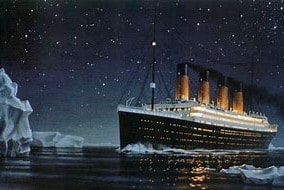We had one of those logy days yesterday when you want to put on an old movie and contemplate your navel. Contemplating your navel is an old saying that we used in our youth which means excessive self-contemplation, otherwise known as omphaloskepsis. It is a word derived from the Ancient Greek language and can be an aid to meditation. The phrases today, such as contemplating one’s navel or navel-gazing, refer to self-absorbed pursuits.
Well, that we did. We plopped ourselves on the couch and turned on the Old Movie Channel. And there it was, the original 1953 Titanic movie. Maggie’s father had been drawn in by this story of the largest and most glamorous ship that was lost on the fifth night of its maiden voyage. She still has her fathers’ book, the 1955 A Night To Remember. It is a remarkable minute-by-minute account of the tragic story of the Titanic’s last night at sea in 1912 as it sped through the chilly North Atlantic waters.
Fourteen years prior in 1898, a struggling author named Morgan Robertson wrote a novel about a fabulous Atlantic liner which was far larger than any other that had been built. In his story, he loaded the ship with rich and complacent people. As the story goes, the ship wrecked one cold April night in the North Atlantic as it struck an iceberg. The book is called Futility.
Robertson’s fictitious ship in 1898, and that of the Titanic of 1912, had very similar characteristics. Both ships were approximately the same weight, length, and speed capability. Both could carry about 3000 individuals and both had enough lifeboats for only a fraction of this number. Robertson called his ship the Titan and the White Star Line called its ship the Titanic. Both the fictional ship and the Titanic struck a fatal iceberg and went down on an April night in cold, glassy waters. Both were labeled “unsinkable.”
As we watched the 1953 version of Titanic, we were struck by the notion that the ship was unsinkable and that a little over 700 persons survived the plunging of this celebrated ship. As the movie ended, it didn’t take much to drift back to a discussion about modern day politics. Was there a correlation between the unsinkability of the Titanic and that of the United States?
Like the Titanic, we believed this country was unsinkable. But with what is now knocking on our door, we have much to consider. Are challenges such as climate change, domestic terrorism, and pandemics – current and future – just the tip of the iceberg? Consider for a moment Biden’s withdrawal from Afghanistan. Is it possible that he believes that our country’s biggest concern right now is on the home front and that of domestic terrorism? Fears about a civil war in the US is not unheard of as we see radical conservatives moving in droves to red states like Montana and Florida – guns loaded. We ask ourselves the serious question, is this country still unsinkable?
All this would make a great movie if we weren’t living in it from day to day. Maybe the next time we want to contemplate our navels, we should just turn on the Hallmark Channel instead.



